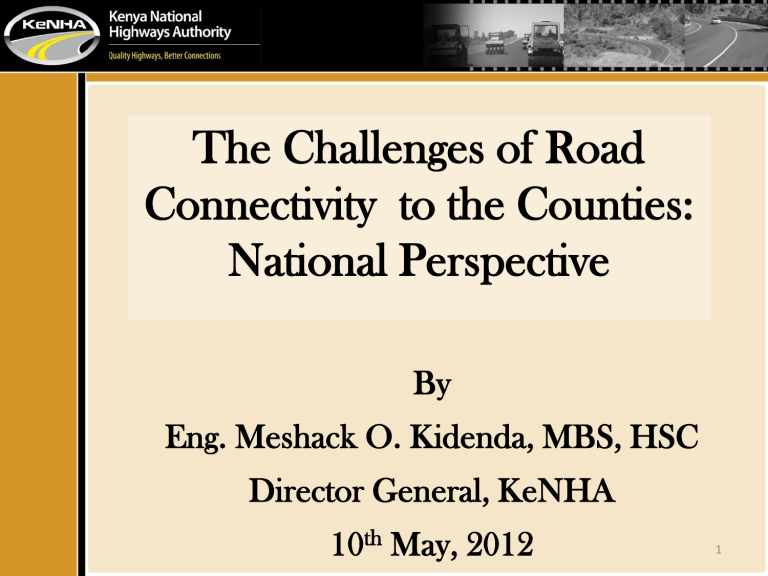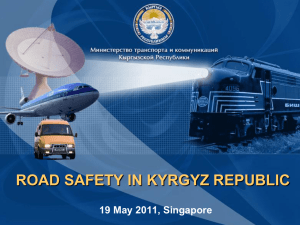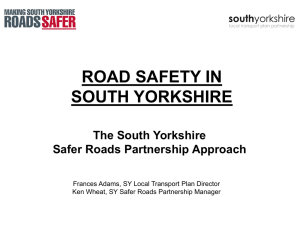- The Institution of Engineers of Kenya

The Challenges of Road
Connectivity to the Counties:
National Perspective
By
Eng. Meshack O. Kidenda, MBS, HSC
Director General, KeNHA
10
th
May, 2012
1
CONTENTS:
1. Introduction;
2. Understanding Road Connectivity;
3. Challenges of Road Connectivity to the Counties;
4. Directions for the future; and
5. Conclusion .
2
Kenya
National
Highways
Authority
A road agency established under the Kenya Roads
Act 2007, responsible for the management, development, rehabilitation and maintenance of
International Roads (Class A), National Trunk Roads
(Class B), and Primary Roads (Class C).
Our Vision
“A leading Highways Authority committed to quality, safe and adequate national roads”.
Our Mission
“To construct and manage national roads that enhance socio-economic growth and prosperity”.
Our Mandate
“To Manage, develop, rehabilitate and maintain national roads”.
3
INTRODUCTION:
Kenya adopted a new Constitution in August,
2010. The Constitution introduced:
a devolved system with two levels of government; &
its territory was divided into (47) counties;
In accordance with the Constitution:
The public road network has been categorized into: national trunk roads and county roads;
4
Schedule 4 Responsibility for Roads
• County Governments are responsible for county roads, street lighting, traffic and parking, public road transport.
• National Government is responsible for transport and Communication including road traffic and the construction and operations of the national trunk roads
5
National Travel
• To the National Capital, parliament and senate;
• To National facilities, referral hospitals, international airports, Ports; and
• Inter County journeys and trade.
6
CURRENT STATUS:
KeNHA manages 14,090 kms of class A,B and
C roads.
Although fairly spread across the country, the roads are generally in a better state in the more densely populated areas (Northern corridor)
7
Kms
Class A 3,588
Class B 2,645
Class C 7,857
Total 14,090
8
NO COUNTY
1 Baringo
2 Bomet
3 Bungoma
4 Busia
5 Embu
6 Garissa
7 Homa Bay
8 Isiolo
9 Kajiado
10 Kakamega
11 Keiyo-Marakwet
12 Kericho
13 Kiambu
14 Kilifi
ABC ROADS (kms)
427.1
152.9
221.9
207.4
132.8
365.6
244.1
194.7
535.4
269.3
299.1
286.4
416.9
NO COUNTY
15 Kirinyaga
16 Kisii
17 Kisumu
18 Kitui
19 Kwale
20 Laikipia
21 Lamu
22 Machakos
23 Makueni
24 Mandera
25 Marsabit
26 Meru
27 Migori
28 Mombasa
29 Murang'a
30 Nairobi
ABC ROADS (kms)
121.9
148.9
278.9
531.3
341.2
297.5
93.6
413.0
311.1
273.6
799.0
333.0
164.8
61.6
221.4
231.3
10
31 Nakuru
32 Nandi
33 Narok
34 Nyamira
35 Nyandarua
36 Nyeri
37 Samburu
38 Siaya
39 Taita-Taveta
40 Tana River
41 Tharaka-Nithi
42 Trans-Nzoia
43 Turkana
44 Uasin Gishu
45 Vihiga
46 Wajir
47 West Pokot
TOTAL
455.5
165.1
554.5
97.2
270.9
161.2
406.5
260.5
415.4
384.8
21.5
150.7
810.5
316.4
79.9
553.7
189.0
UNDERSTANDING ROAD CONNECTIVITY :
What is Road Connectivity?
It refers to the density of connections in the road network and the directness of the links.
A well-connected road network has:
many short links;
numerous intersections; and
minimal dead-ends.
12
As road connectivity to the Counties increases:
travel distances decrease & route options increase, allowing more direct travel between destinations, creating a more accessible and resilient system;
there is diversification of activities & income sources thus playing a positive role in socio economic development;
better routing opportunities for emergency and delivery vehicles are provided.
13
Challenges of Road Connectivity to the Counties:
1.
Severe Resource (Funds) Strain:
The major constraint to the provision of appropriate road network is the high level of investment required to develop and maintain the national road network.
14
2.
Sub Sector Reform:
To ensure implementation of the new constitution, it is necessary to review the legal, institutional and administrative framework for the management of the country’s road subsector.
This is work in progress
15
This revised framework will define:
the funding arrangements for road construction and management for both
National trunk roads and County roads; and
the level of cooperation and consultation between the two governments.
16
3.
Land Acquisition for Right of Way:
County roads serve as linkage to urban centers and markets and farms within the counties.
Cost of acquiring this Right of Way and lack of coordinated spatial planning is a challenge.
17
4.
Equitable Road development:
Some parts of the network and some Counties have in the past received more attention than others and hence have better roads,
It will be a challenge to correct imbalance and achieve equity in a scenario where funding is inadequate.
Connectivity to Counties by the national trunk roads to an agreed standard will be undertaken even where traffic volumes remain low.
18
5.
Low capacity of local contractors:
The existing local contracting capacity is inadequate. This inadequacy fails to facilitate the development and connectivity to the county roads.
19
6.
A vast unclassified network of roads:
The country’s road sub sector has an unclassified road network length of 100,000 km.
To facilitate road development and in turn increase connectivity its critical to have in place an adequate classification system consistent with the mandates of the two levels of government as stipulated in the Constitution & for prioritization purposes .
20
7.
Inadequate Technical Expertise:
Under the Constitution, the national government is tasked with providing technical assistance to the counties.
There is a large requirement by the national and county governments of adequate manpower who are technically competent.
21
8.
Inadequate Road Construction Plant &
Equipment:
The plant and equipment currently available for hire by the contractors and KeNHA are inadequate.
This results in delays in road construction, which in turn affect the rate of connectivity to the various County roads.
22
9. Interconnection between counties:
The current challenges in interconnectivity between counties include
Maralal neighbours Turkana. How do you get from
Maralal to Lodwar?
Taveta borders Kajiado. What is the road connectivity for trade?
Narok and Kajiado. Do you go through Nakuru,
Nairobi to go to county?
Are we to open new national roads to link them?
23
DIRECTIONS FOR THE FUTURE: a) Clarified Responsibility:
Sub sector reform is currently ongoing to promote role clarity and accountability for all actors.
b) Re-classification of the Road network :
To set out criteria for road classification consistent with the mandates of the two levels of government as stipulated in the Fourth Schedule of
Constitution.
24
DIRECTIONS FOR THE FUTURE: c) Commercialized Management:
The sub sector is currently putting in measures to create a conducive environment for increased private sector participation of roads.
This is to ease the resource strain on the
National government.
Private sector participation in the form of Public
Private Partnerships (PPPs) is ongoing.
25
d) Capacity Building of Local Contractors:
The sub-sector is currently reviewing contractor classification system and local contractor capacity and training to ensure effective management of contracts in Kenya;
This is to ensure that only contractors with the requisite competence and adequate resources are awarded contracts; thus facilitating that “Value for money” .
26
d) Implementation of RSIP:
The RSIP gives a plan for development of roads across the country;
This will enhance transparency and planning.
27
CONCLUSION:
Attainment of Vision 2030 and Millennium
Development Goals (MDGs) will depend heavily on the quality and span of connectivity of the country’s road network.
“It is not a strong economy that leads to good roads, but rather good roads that lead to a strong economy ”
THANK YOU!
Questions?
29









